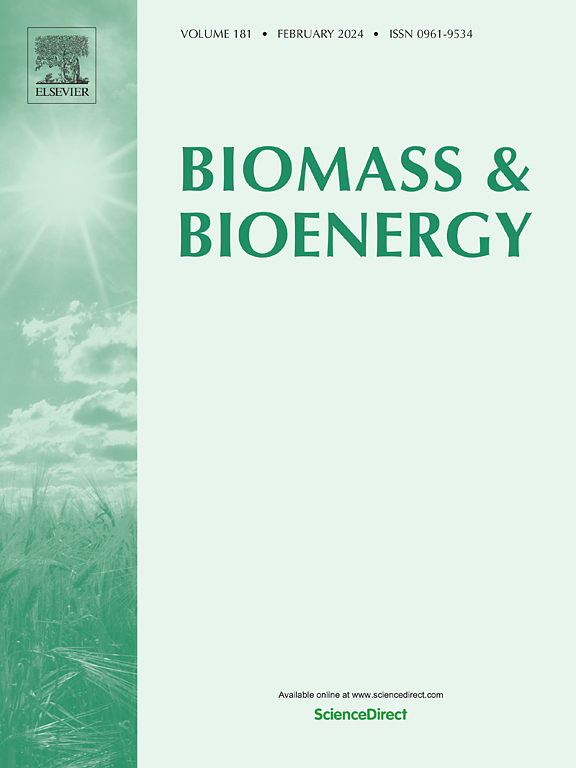甘蔗生物精炼厂的生物基丙烯和丙烯腈生产:通过技术经济和环境评估确定首选生产路线
IF 5.8
2区 生物学
Q1 AGRICULTURAL ENGINEERING
引用次数: 0
摘要
为了评估经济可行性和环境可持续性,对现有甘蔗厂附属的能源自给自足生物炼油厂生产丙烯和丙烯腈的四种替代糖衍生化学中间体进行了比较。Aspen Plus® 工艺模拟将甲醇沼生产的乙醇和异丙醇作为丙烯生产的中间体,而将甲醇沼生产的丙烯和 3- 羟基丙酸 (3-HP) 作为丙烯腈生产的中间体进行比较。以乙醇为原料生产丙烯(3634 美元/吨)、以异丙醇为原料生产丙烯(8151 美元/吨)、以丙烯为原料生产丙烯腈(4698 美元/吨)和以 3-HP 为原料生产丙烯腈(5957 美元/吨)的最低销售价格(MSP)分别比化石基同等产品的市场价格高 280%、752%、302% 和 409%。尽管如此,丙烯生物炼制厂的温室气体(GHG)排放量减少了 97%,而丙烯腈生物炼制厂的温室气体排放量比化石基生产工艺减少了 43%。根据工艺产量、能源需求和温室气体排放量,乙醇被确定为所有四种生物炼制方案的首选中间路线,而工业生产则需要大量的价格溢价。本文章由计算机程序翻译,如有差异,请以英文原文为准。
Biobased propylene and acrylonitrile production in a sugarcane biorefinery: Identification of preferred production routes via techno-economic and environmental assessments
Four alternative, sugar-derived chemical intermediates were compared for the production of propylene and acrylonitrile in energy self-sufficient biorefineries, annexed to an existing sugarcane mill, to assess economic feasibility and environmental sustainability. Aspen Plus® process simulations considered ethanol and isopropanol produced from A-molasses as intermediates for propylene production, while propylene and 3-hydroxypropionic acid (3-HP) from A-molasses were compared for acrylonitrile production. The minimum selling prices (MSPs) for propylene-from-ethanol (3634 $/t), propylene-from-isopropanol (8151 $/t), acrylonitrile-from-propylene (4698 $/t), and acrylonitrile-from-3-HP (5957 $/t) were 280 %, 752 %, 302 % and 409 % above the market prices of fossil-based equivalents. Nonetheless, the propylene biorefineries achieved up to 97 % reduction in greenhouse gas (GHG) emissions, whilst acrylonitrile biorefineries had up to 43 % reduction compared to fossil-based production processes. Based on process yields, energy demand and GHG emissions, ethanol was identified as the preferred intermediate route for all four biorefinery scenarios, while substantial price-premiums will be required for industrial production.
求助全文
通过发布文献求助,成功后即可免费获取论文全文。
去求助
来源期刊

Biomass & Bioenergy
工程技术-能源与燃料
CiteScore
11.50
自引率
3.30%
发文量
258
审稿时长
60 days
期刊介绍:
Biomass & Bioenergy is an international journal publishing original research papers and short communications, review articles and case studies on biological resources, chemical and biological processes, and biomass products for new renewable sources of energy and materials.
The scope of the journal extends to the environmental, management and economic aspects of biomass and bioenergy.
Key areas covered by the journal:
• Biomass: sources, energy crop production processes, genetic improvements, composition. Please note that research on these biomass subjects must be linked directly to bioenergy generation.
• Biological Residues: residues/rests from agricultural production, forestry and plantations (palm, sugar etc), processing industries, and municipal sources (MSW). Papers on the use of biomass residues through innovative processes/technological novelty and/or consideration of feedstock/system sustainability (or unsustainability) are welcomed. However waste treatment processes and pollution control or mitigation which are only tangentially related to bioenergy are not in the scope of the journal, as they are more suited to publications in the environmental arena. Papers that describe conventional waste streams (ie well described in existing literature) that do not empirically address ''new'' added value from the process are not suitable for submission to the journal.
• Bioenergy Processes: fermentations, thermochemical conversions, liquid and gaseous fuels, and petrochemical substitutes
• Bioenergy Utilization: direct combustion, gasification, electricity production, chemical processes, and by-product remediation
• Biomass and the Environment: carbon cycle, the net energy efficiency of bioenergy systems, assessment of sustainability, and biodiversity issues.
 求助内容:
求助内容: 应助结果提醒方式:
应助结果提醒方式:


